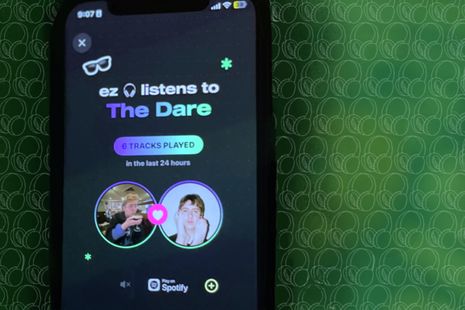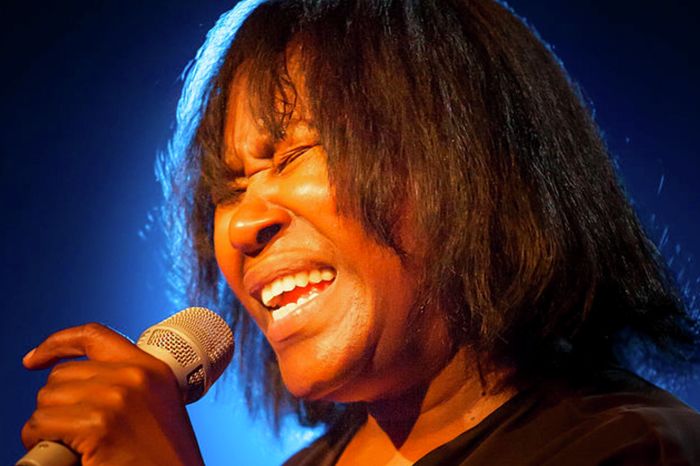Big Budder is watching you
Ezra Izer unpacks the rise of Airbuds, the app turning music into a public spectacle and blurring the line between genuine listening and performative curation

Despite being two years old, Airbuds has recently experienced a meteoric rise, drawing in thousands of new users with its distinctive blend of music-sharing and real-time social interaction. Boasting over 47,000 reviews and a glowing 4.8-star rating on the App Store, the app has clearly struck a chord with a young, music-obsessed audience by transforming the solitary act of listening into a shared, public event. Each song you play is instantly visible to your friends, providing a running auditory commentary on your study sessions or evening strolls back from Sidge. It’s as though the app took the voyeuristic charm of Spotify Wrapped and made it omnipresent, giving your friends unfettered access to your listening habits.
“It’s as though the app took the voyeuristic charm of Spotify Wrapped and made it omnipresent, giving your friends unfettered access to your listening habits”
But in an age where social media has infiltrated nearly every corner of life (because, obviously we weren’t sharing enough already) Airbuds raises a compelling question: does this heightened visibility encourage more authentic listening, or are we simply curating our playlists to project a certain image, driven by the silent pressure of constant surveillance?
What is Airbuds, and Why Does Everyone Care?
At its core, Airbuds is like the overly caffeinated cousin of Spotify’s friend activity feed. It doesn’t just show you what your friends are listening to; it does so in real time, letting you jump into the same vibe, comment on their song choices, or even toss in a cheeky Orwellian-style sticker to remind them that yes, you can see they’re playing ‘Pink Matter’ by Frank Ocean for the tenth time that day. For anyone who thrives on the intersection of streaming and social validation, Airbuds provides the perfect tool to keep tabs on your friends’ musical tastes — all at the low, low price of letting them keep tabs on yours.

But this isn’t just about passive observation. No, Airbuds is far more ambitious. Each week, the app compiles a personalised music roundup — a snapshot of your most-played tracks, forever two taps away from being dropped into your group chats. (Cue your friends debating intervention techniques because you’re still listening to that one British-looking guy with the sunglasses singing about the ‘gurlz that do druhgz’.) It’s a fascinating twist on the annual Wrapped ritual that doesn’t come just once a year; instead, it gives your friends an ongoing look at who you are musically, and — let’s be honest — how you want them to see you. And while it’s tempting to view this as yet another way to curate our personas, there’s something more profound at play here.
Playlist Pressure: When Your Songs Become Your Status
In today’s hyperconnected world, music has become another form of social currency. Much like the TikToks we repost or the clothes we wear, the songs we play contribute to our personal brands. Airbuds takes this to the extreme, offering complete transparency into our musical choices. Now, every song queued is another obnoxious brushstroke on the canvas of your personal identity. In short, the social media-fication of music has arrived, and suddenly, even your guilty-pleasure throwback to ‘Mr. Brightside’ carries social weight.
“Music, at its heart, has always been social, and Airbuds simply turns up the volume on that conversation”
Of course, this kind of visibility has its effects. Some argue that Airbuds turns listening into an exercise in performativity, carefully curating your song choices to appear more musically enlightened than you are. But others say the opposite: with every track on full display, the effort needed to maintain a pretence becomes too draining. Eventually, we might all just lean into our unashamed love for the Glee soundtrack because, really, who can keep up appearances under 24/7 surveillance?
Performativity vs. Authenticity in the Music-Feed Age
Here’s where Airbuds throws us a delicious paradox: it actually pushes us towards authenticity by exposing our every minuscule musical instinct. The pressure to constantly perform might backfire, leading us to abandon the need to project a certain identity and embrace our raw, unfiltered interests.
That said, performativity is still very much alive and well. Knowing that our listening habits are public domain might lead us to shove our hyper-pop favourites aside for delicately selected indie tracks. If we’ve mastered the art of curating Instagram grids, why wouldn’t we extend the same energy to our music feeds?
Still, the real kicker is this: in a world where everything is shared, it’s not just the songs themselves that matter — it’s the interaction around them. Music, at its heart, has always been social, and Airbuds simply turns up the volume on that conversation.
Addressing the Sonic Surveillance State
Airbuds also signals a move away from algorithm-driven discovery. Instead of being fed recommendations based on your listening history, you’re interacting with new tracks through a feed of what your friends are playing in real time. This more collaborative, human-centric process is something of a return to the days of exchanging mixtapes, only with the modern adage of subconscious sharing — where your choices are broadcast whether you like it or not.
As we embrace this era of ever-visible choices and immediate reactions, Airbuds might very well represent the future of how we experience music. Whether this heralds a new era of sonic sincerity or just more noise, well, that’s for your next listening spree to decide.
 News / Cambridge study finds students learn better with notes than AI13 December 2025
News / Cambridge study finds students learn better with notes than AI13 December 2025 News / Uni Scout and Guide Club affirms trans inclusion 12 December 2025
News / Uni Scout and Guide Club affirms trans inclusion 12 December 2025 News / Cambridge Vet School gets lifeline year to stay accredited28 November 2025
News / Cambridge Vet School gets lifeline year to stay accredited28 November 2025 Comment / The magic of an eight-week term15 December 2025
Comment / The magic of an eight-week term15 December 2025 Film & TV / Making a case for reality TV13 December 2025
Film & TV / Making a case for reality TV13 December 2025










